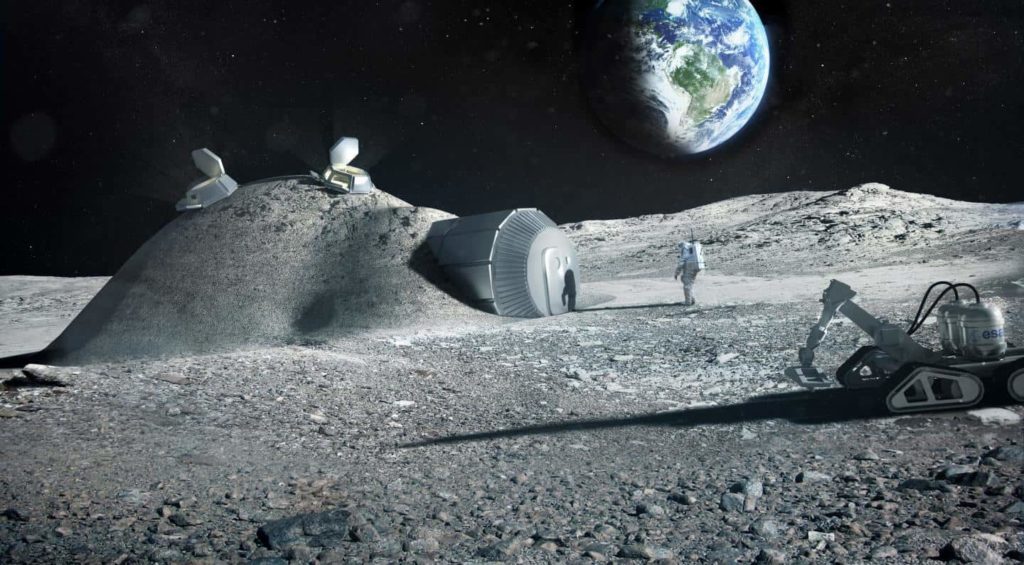by Jonathan O’Callaghan, Horizon

Eavesdropping on the shudders and groans echoing deep inside alien worlds like Mars and the moon is revealing what lies far beneath their surfaces and could teach us more about how our own planet formed.
On Earth, we can feel and see the often terrifying results of the tectonic plates shifting beneath our feet. As they grind together, they generate earthquakes that produce seismic waves that reverberate through layers of rock, magma and metal deep inside our planet.
Scientists can monitor these seismic waves using a variety of instruments that pick up even faint vibrations passing through the Earth’s crust and core. Studying how the behaviour of these waves changes as they pass through our planet’s interior, reveals details about what lies deep inside the Earth, far out of our sight.
But Earth is not the only place in our solar system that experiences seismic activity. Both Mars and the moon also experience quakes – although for different reasons than here on Earth. Seismometers deployed on the moon and – more recently – on Mars, are allowing researchers to probe the interiors of both of these distant worlds.
The results show that while on the surface Earth, Mars and the moon are not alike, beneath it they have more in common than might be suspected, but with some striking differences.
Moonquakes
Moonquakes – as they are known on the moon – are produced as a result of meteoroids hitting the surface or by the gravitational pull of the Earth squeezing and stretching the moon’s interior, in a similar way to the moon’s tidal pull on Earth’s oceans. As the lunar interior cools, it is also causing the moon to shrink and shrivel like a raisin, causing other quakes as the crust buckles and breaks. Heat from the sun can also produce thermal quakes due to the temperature difference in the lunar crust as the moon emerges from its night.
Five seismometers have been deployed on the moon, left by astronauts during the Apollo missions between 1969 to 1972. The first lunar seismometer was set up by Neil Armstrong and Buzz Aldrin on the Apollo 11 mission. After deploying the instrument, Aldrin stamped on the lunar surface to check it was working – with the instrument picking up the waves produced by his foot.
The other four seismometers were left by subsequent missions and they were operated until 1977, five years after the final Apollo astronauts set foot on the lunar surface. But some 43 years later, their data is still being pored over by scientists.
SeisMo is one project that recently re-analysed the data. ‘We were trying to apply a technique which is used quite commonly on Earth,’ said Dr Ceri Nunn, from NASA’s Jet Propulsion Laboratory in California, US, the lead scientist on the project. ‘If you cross-correlate the noise between stations, you can actually see waves travelling between them. The first station is a source, and the second station is a receiver.’
Unfortunately, Dr Nunn was unable to pick up similar patterns in the data from the moon. But that failure revealed something else about the moon – namely that it doesn’t appear to have surface waves, which get trapped in the upper layers of rock and bounce around. ‘That wave doesn’t seem to exist on the moon,’ said Dr Nunn.
This suggests the upper layer of the moon’s surface is likely highly fractured, and up to 100 kilometres thick, both of which disturb the movement of seismic waves across the surface. ‘This highly fractured layer is changing the way that seismic waves behave,’ said Dr Nunn.
Currently there are no active seismometers on the moon. But there are proposals to send new seismometers back to the lunar surface in future missions.
‘We’re interested in using much smaller seismometers, possibly being delivered by penetrators, which are almost like missile-shaped objects,’ said Dr Nunn. ‘You put a very small seismometer in the back and then launch them either from a descending lander or directly from Earth.’
Questions
Putting new seismometers on the moon could answer several outstanding questions, such as why there are large structural differences between the near side of the moon that points towards us and the far side that points away.
‘(That could be) related to the internal structure,’ said Dr Nunn. ‘There’s a theory (the moon) was hit again after it formed by another moon, and that’s why you get this strange asymmetry. Exploring the internal structure would be interesting. And on top of that we’d like to constrain how thick the core is.’
Understanding this could help to prove theories about how these early, cataclysmic impacts around the time the Earth and moon were forming helped to determine the structures they have today.
On Mars, however, things are a bit different. Marsquakes are produced not by tidal interactions, but by the planet cooling and contracting, producing deep stresses. Meteoroid impacts are believed to play a part too, just like on the moon, sending seismic waves around the planet.
The existence of marsquakes had never been proven until researchers landed a seismometer on the red planet in 2018 as part of NASA’s InSight mission. The InSight Mars lander detected the first-ever definitive marsquake on 6 April 2019 using its Seismic Experiment for Interior Structure (SEIS) instrument, which had been gently placed on the surface by the lander’s robotic arm shortly after it touched down on 26 November 2018. Since then about 500 subsequent events have also been detected.
Volcanic activity
While most of the marsquakes have been relatively small, some of these have been large enough – almost equivalent to a magnitude 4 earthquake – to be traced back to their source, an area known as Cerberus Fossae, about 1,600 kilometres east of InSight. It is thought the quakes there are being caused by the build-up of stress as fractures in the Martian crust are stretched, possibly by volcanic activity.
While the larger quakes appear to originate from the mantle beneath the Martian crust, the smaller marsquakes are thought to begin in the crust itself. The velocity of seismic waves in the upper Martian crust, however, in the first eight to 11 kilometres, seems to be about 50% lower than in similar rocks on Earth.
Researchers who are part of the GeoInSight project have been studying the geology of the surface around the InSight landing site to understand more about what might be going on. They used images and data from NASA’s Mars Reconnaissance Orbiter (MRO) to study the Elysium Planitia area before InSight arrived.
The images revealed that there are lava flows 200 to 300 metres beneath the lander, according to Dr Lu Pan from the University of Copenhagen, Denmark, the project coordinator on GeoInsight. ‘But beneath those lava flows, we have sedimentary rocks and clay-bearing rocks a few kilometres in depth,’ she said.
This layering is one explanation for the lower velocity of the seismic waves, says Dr Pan, because sedimentary rocks have a high porosity that could slow the waves down. Another possibility is that the upper crust has been heavily damaged and fractured by meteorite impacts and other processes, producing more resistance for the waves.
The findings also have implications for some of InSight’s other results, noted Dr Pan. ‘For example, one of the exciting discoveries of InSight was the magnetic field, (which was) ten times more than we observed from orbit,’ she said. ‘Having established the stratigraphy (the layering of the rocks), we could help put some constraints on where the magnetic field came from – stratigraphy from before 3.9 billion years (ago).’
Humming
While InSight will continue to probe the interior of Mars with its SEIS instrument, scientists are keen to also unravel the mystery of a strange reading it has been picking up.
‘There’s this humming at a specific frequency that occurs when there’s another event,’ said Dr Pan. ‘We don’t really understand what it is. Sometimes when there’s a quake, we see that humming come afterwards. We don’t really have a good analogue on Earth.’
As InSight and its instruments listen into to the inner workings of the red planet, it might help reveal the source of this hum and reveal what really lies deep inside this alien world.
The research in this article was funded by the EU. If you liked this article, please consider sharing it on social media.
This post Moonquakes and marsquakes: How we peer inside other worlds was originally published on Horizon: the EU Research & Innovation magazine | European Commission.











More Stories
SLEEP LIKE A CAVEMAN TO BOOST BRAIN POWER
Biotechnology Could Change the Cattle Industry. Will it Succeed?
How understanding nature made the atomic bomb inevitable